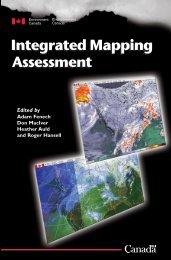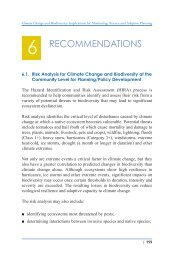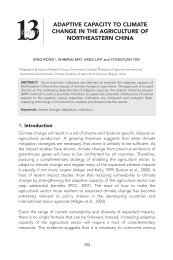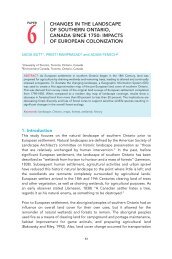Paper 3: Climate Change Adaptation for Neophytes - UPEI Projects
Paper 3: Climate Change Adaptation for Neophytes - UPEI Projects
Paper 3: Climate Change Adaptation for Neophytes - UPEI Projects
Create successful ePaper yourself
Turn your PDF publications into a flip-book with our unique Google optimized e-Paper software.
LINKING CLIMATE MODELS TO POLICY AND DECISION-MAKINGsomewhat imprecise this metric is easy to compute and gives a larger sense ofthe author’s presence. Table 3 identifies the citation\paper ratio which is thenumber of articles that cite the author over the number of papers written by theauthor in the CCA database. This ratio allows us to identify authors whomay not write a great deal in the field, but still have a high number of citations(e.g. Holling, 2004, Nordhaus 1995). The only authors that make the top 20 ofall three measures are: Tol, R.S.J.; Rosenzweig,C.; Burton, I.; Yohe, G.; Adger,W.N.; Easterling, W.; Huq, S.; Mendelsohn,R. ; Dixon, R.K.; Kane, S.; Ebi, K.L.;and Fankhauser, S.3.2 Structural and Contextual OverviewThe metrics from the previous section are quite useful in terms of identifying keyarticles, journals and authors but offer no guidance in terms of content. Tofacilitate a broader understanding of current trends, we offer two additionaltechniques <strong>for</strong> perceiving patterns within the literature. In the first section weexamine the relative and temporal incidence of concepts by means of simpleword counts. In the second we attempt to construct a structural scaffolding <strong>for</strong>the CCA literature, as guided by a systems perspective, and the occurrence ofkey topics in the literature.3.2.1 Relative Concept IncidenceIn this section, we employ simple counts (see Table 4) of specific words orphrases (i.e. as inferred by the literature) to roughly gauge their comparativeutilisation in the field through time. A word count is the aggregate number ofoccurrences of specific words or combinations of words within the CCA dataset(i.e. a single occurrence represents the presence of a word/combination, one ormore times, within the article’s title, abstract or keywords). It can be used todetermine when a word or phrase first appeared within the literature, andwhether or not it was or has been adopted.Two examples will offer a sense of the utility of this method. One of the majorissues associated with CCA, is the conceptual and practical relationship betweenadaptation and mitigation as strategies <strong>for</strong> responding to climate change. TheWorking Group II report of the AR4 refers specifically to this issue throughout,and a special of <strong>Climate</strong> Policy (Johnson et al., 2007) focuses entirely upon thisissue. At its most simplified, this issue is about determining the optimal mix ofmitigation and/or adaptation <strong>for</strong> responding to climate change (Kane andShogren, 2000). If we search <strong>for</strong> articles in which adaptation and mitigation cooccur,we can obtain a rough sense of when these issues emerged, and howprevalent they have been since then. Referring to Table 4 we can see that the60










